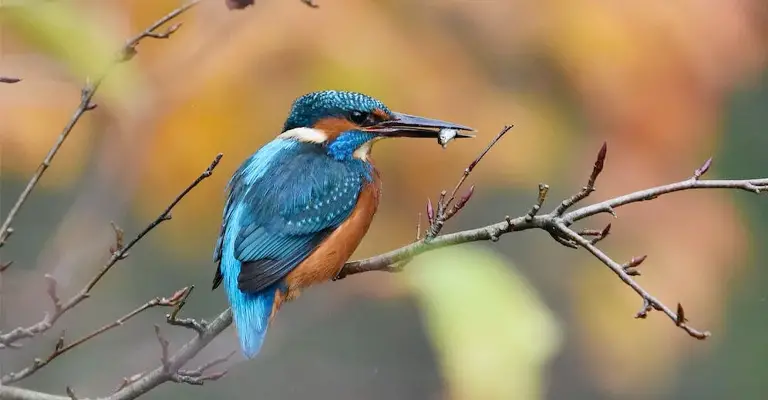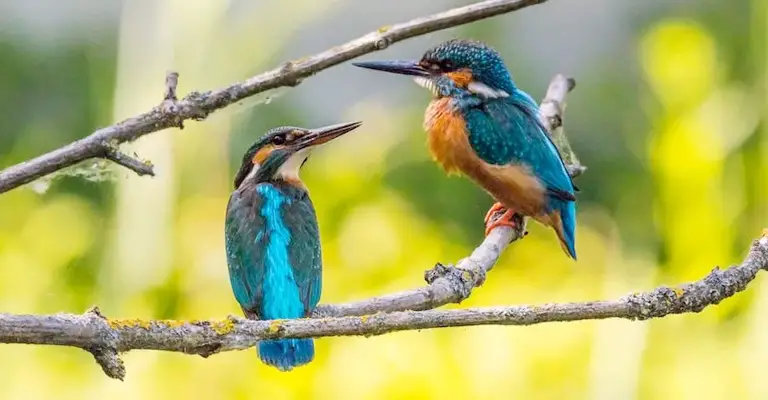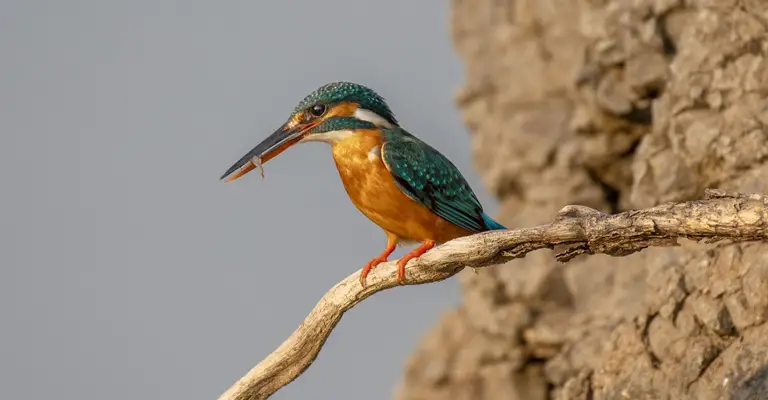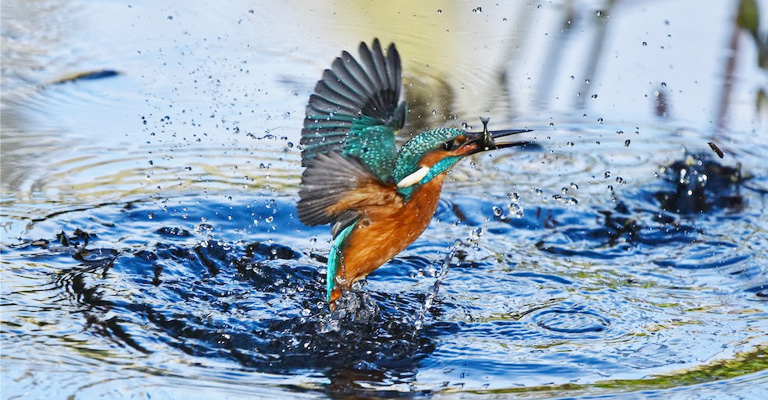In the realm of avian wonders, the Common Kingfisher stands as a marvel of precision and grace. While its vibrant plumage often captures our attention, it’s the bird’s remarkable ability to balance on a tiny, swaying reed that truly exemplifies its extraordinary adaptations.
In this blog post, we delve into the intriguing question ‘How Can a Common Kingfisher Bird Balance on a Tiny Swaying Reed?’.
From their lightweight bodies and sharp claws to their keen sense of balance, Common Kingfishers have evolved a suite of adaptations tailored to their watery habitats.
We’ll explore the intricacies of their physical traits and behaviors that allow them to perch on reeds with such finesse. As we unravel the mystery behind this remarkable skill, we gain a deeper appreciation for the wonders of the natural world. So, stay focused.

Kingfisher’s Body Structure
The Kingfisher, a remarkable bird belonging to the Alcedinidae family, boasts a distinctive body structure adapted for its aquatic lifestyle and hunting habits. It features a sturdy beak, often with a dagger-like shape, designed for precision strikes when catching fish.
Its wings are relatively short and rounded, aiding in rapid flight and maneuverability during hunting. Kingfishers possess powerful leg muscles for perching and gripping branches near water bodies.
Their eyes are large, aiding in underwater vision when hunting for prey, and they have a nictitating membrane to protect their eyes while diving. Additionally, they display vibrant plumage, often featuring striking blue or green hues, for camouflage and mate attraction.
The Kingfisher’s body structure showcases an exquisite blend of adaptations that enable it to excel in its aquatic habitat, making it a captivating and agile bird in both appearance and function.
The Anatomical Features of Kingfishers of Balance
Kingfishers possess several anatomical features that contribute to their exceptional balance, which is crucial for their hunting and perching activities. These features include:
Large Head and Beak
Kingfishers have relatively large heads and beaks, which serve as important counterbalances to their body weight. The heavy beak, in particular, helps stabilize their body during dives and when catching prey.
Short Tail
Kingfishers typically have short tails, which reduce drag and enhance stability during flight. This design helps them maintain balance while hovering over the water before diving for fish.
Strong Neck Muscles
Their powerful neck muscles provide precise control of head movement, allowing them to focus keenly on potential prey below the water’s surface while keeping the rest of their body stable.
Large Feet with Sharp Claws
Kingfishers have large feet with sharp, curved claws that are well-suited for gripping branches and perches securely. This ensures they can maintain balance while perched over the water or on a branch.
Wings and Flight Adaptations
Kingfishers’ wings are short and rounded, aiding in agile flight and precise aerial maneuvers. Their flight pattern is incredibly stable, enabling them to hover effortlessly over the water before making a rapid dive.
Vestibular System
Like most birds, kingfishers have a well-developed vestibular system in their inner ear, which provides them with a strong sense of balance. This system helps them maintain equilibrium during rapid movements and aerial acrobatics.
Streamlined Body
Kingfishers have a sleek and streamlined body shape, reducing air resistance and improving their aerodynamic stability during flight.
These anatomical adaptations collectively contribute to the remarkable balance of kingfishers, allowing them to execute intricate hunting techniques with precision and grace, whether they are perched on branches, hovering in mid-air, or diving into the water to catch their aquatic prey.
How Can a Common Kingfisher Bird Balance on a Tiny Swaying Reed?

A Common Kingfisher (Alcedo at this) is capable of balancing on a tiny swaying reed due to a combination of its physical adaptations, specialized behaviors, and instinctual skills. Here’s how it achieves this remarkable feat:
Lightweight Body
Kingfishers have relatively small and lightweight bodies, which minimize the pressure they exert on the reed or perch. This reduces the risk of bending or breaking the reed due to their weight.
Sharp Claws
Kingfishers have sharp and curved claws on their feet. These claws provide an excellent grip on narrow surfaces like reeds, allowing them to maintain balance even on swaying or unstable perches.
Strong Leg Muscles
The kingfisher’s leg muscles are well-developed and powerful. This helps them grip the reed firmly, providing stability even as the reed sways in the wind or water currents.
Constant Adjustments
Kingfishers continuously make subtle adjustments to their body position and foot grip to counteract the movement of the reed. This constant monitoring and fine-tuning of their posture helps them stay balanced.
Instinctual Reflexes
Kingfishers have evolved to instinctively sense changes in their perch’s movement. They can react quickly to maintain balance, almost as if it’s a reflex action.
Low Center of Gravity
The kingfisher’s body is designed to have a low center of gravity, which enhances stability. This allows them to balance on narrow, swaying perches with greater ease.
Practice
Young kingfishers often practice perching on unstable surfaces, such as reeds, as they develop their balance and coordination skills. This helps them become more proficient at handling such perches as adults.
Experience
Adult kingfishers gain experience over time, learning how to gauge the sway of the reed and adjust their position accordingly. This experience further improves their ability to maintain balance.
A Common Kingfisher’s ability to balance on a tiny swaying reed is the result of a combination of physical adaptations, instinctual behaviors, and learned skills.
Their lightweight bodies, sharp claws, strong leg muscles, and constant adjustments enable them to master the art of perching on such precarious surfaces, allowing them to wait patiently for their prey while staying safe and secure.
Why Do Kingfishers Sit on Tiny Swaying Reed?

Kingfishers, including Common Kingfishers (Alcedo atthis), may sit on tiny swaying reeds for several reasons:
Hunting
Kingfishers are skilled fishermen, and they often use perches like reeds to spot potential prey in the water below. From their elevated position, they can observe fish and aquatic insects, which are their primary sources of food.
The swaying motion of the reed allows them to scan a broader area of water and spot movements that indicate the presence of prey.
Camouflage
The vibrant plumage of kingfishers may be eye-catching, but when perched on reeds or overhanging branches, their colors can help them blend into the surrounding vegetation. This natural camouflage allows them to remain hidden from potential predators and unsuspecting prey.
Patience
Fishing requires patience. By sitting on a swaying reed, kingfishers can remain still for extended periods, conserving energy while they wait for the right moment to dive into the water and catch their prey. The swaying motion may also help them stay alert and focused.
Avoiding Predators
Kingfishers have their share of predators, including larger birds and some mammals. Perching on a swaying reed can make it more challenging for predators to approach them unnoticed, as the reed’s movement can serve as an early warning system.
Territorial Display
Kingfishers are territorial birds, and perching on prominent reeds may serve as a territorial display to ward off intruders. Their presence on these perches signals to other kingfishers that the area is already claimed.
Nesting
During the breeding season, kingfishers often seek out suitable locations for nesting, which may include reeds along the banks of rivers or ponds. Swaying reeds can provide a relatively secure and hidden location for constructing their nests and raising their young.
Kingfishers sit on tiny swaying reeds primarily for hunting, camouflage, patience in waiting for prey, protection from predators, territorial purposes, and potentially for nesting.
Kingfishers’ Strategy of Adaptations to the Environment

Kingfishers have evolved a range of remarkable adaptations that enable them to thrive in their specific aquatic environments. Here are some key strategies and adaptations employed by kingfishers:
Specialized Beak
Kingfishers have long, sharp, and pointed beaks that are adapted for catching fish. The beak’s shape allows for precision strikes when diving into the water to capture prey.
Excellent Eyesight
Kingfishers have keen eyesight, particularly well-suited for underwater vision. This enables them to spot fish and other aquatic prey even in murky water.
Aerial Hunting Skills
Many kingfisher species are skilled aerial hunters. They can hover over the water, using their excellent vision to detect fish near the surface, and then dive with incredible speed and accuracy to catch their prey.
Strong Legs and Feet
Kingfishers have powerful legs and feet with sharp claws. These adaptations help them grip onto branches, reeds, and other perches while hunting, perching, or nesting.
Streamlined Body
Their sleek and streamlined body shape reduces air resistance during flight, making them agile in the air and facilitating efficient dives into the water.
Camouflage
Kingfishers often have colorful plumage that can serve as camouflage when perched on branches or reeds. This helps them blend into their surroundings and avoid detection by both prey and predators.
Territorial Behavior
Kingfishers are territorial birds, and they use vocalizations and displays to establish and defend their territories, ensuring a reliable source of food and nesting sites.
Nesting Habits
They construct their nests in burrows dug into riverbanks or other suitable sites, providing protection for their eggs and chicks from potential threats.
Patience
Kingfishers are known for their patience when hunting. They can sit still for extended periods, waiting for the right moment to strike at prey. This patience is critical for successful fishing.
Adaptability
While they are primarily associated with freshwater habitats, some kingfisher species have adapted to coastal and marine environments, displaying changes in their behavior and diet to suit these settings.
Migratory Behavior
Some kingfisher species are migratory, allowing them to follow their prey and find suitable nesting sites seasonally.
Kingfishers have evolved a suite of physical and behavioral adaptations that make them highly effective hunters and survivors in their aquatic environments.
FAQs
A Common Kingfisher’s ability to balance on a tiny, swaying reed is thanks to its lightweight body, sharp claws, strong leg muscles, constant adjustments, and innate sense of balance. These adaptations allow it to grip the reed securely while compensating for movement.
Common Kingfishers perch on swaying reeds primarily for hunting. The reed’s motion helps them scan a larger area of water for prey like fish and aquatic insects, while their camouflaged plumage keeps them hidden from both predators and prey.
While it’s rare, a Kingfisher can fall off a swaying reed if it loses its balance or misjudges its grip. However, their strong claws and constant adjustments usually prevent such accidents, ensuring they remain adept at perching on these precarious surfaces.
Perching on swaying reeds does carry some risks, such as the possibility of falling into the water or encountering predators. However, Kingfishers have evolved to minimize these risks through their adaptations, vigilance, and quick reflexes, making it a relatively safe strategy for hunting and perching.
Wrapping Up
The Common Kingfisher’s ability to balance on a tiny swaying reed serves as a testament to nature’s ingenuity. Their finely tuned adaptations, honed over millennia, enable these birds to navigate their aquatic environments with unparalleled precision.
From patient hunters to aerial acrobats, they are a true marvel of the avian world. As we admire the Kingfisher’s delicate yet robust equilibrium on these precarious perches, we’re reminded of the countless wonders and mysteries nature continues to unveil.
It’s a testament to the resilience and adaptability of life on Earth, and an inspiration to cherish and protect the delicate ecosystems that sustain such extraordinary beings. Thank you so much.